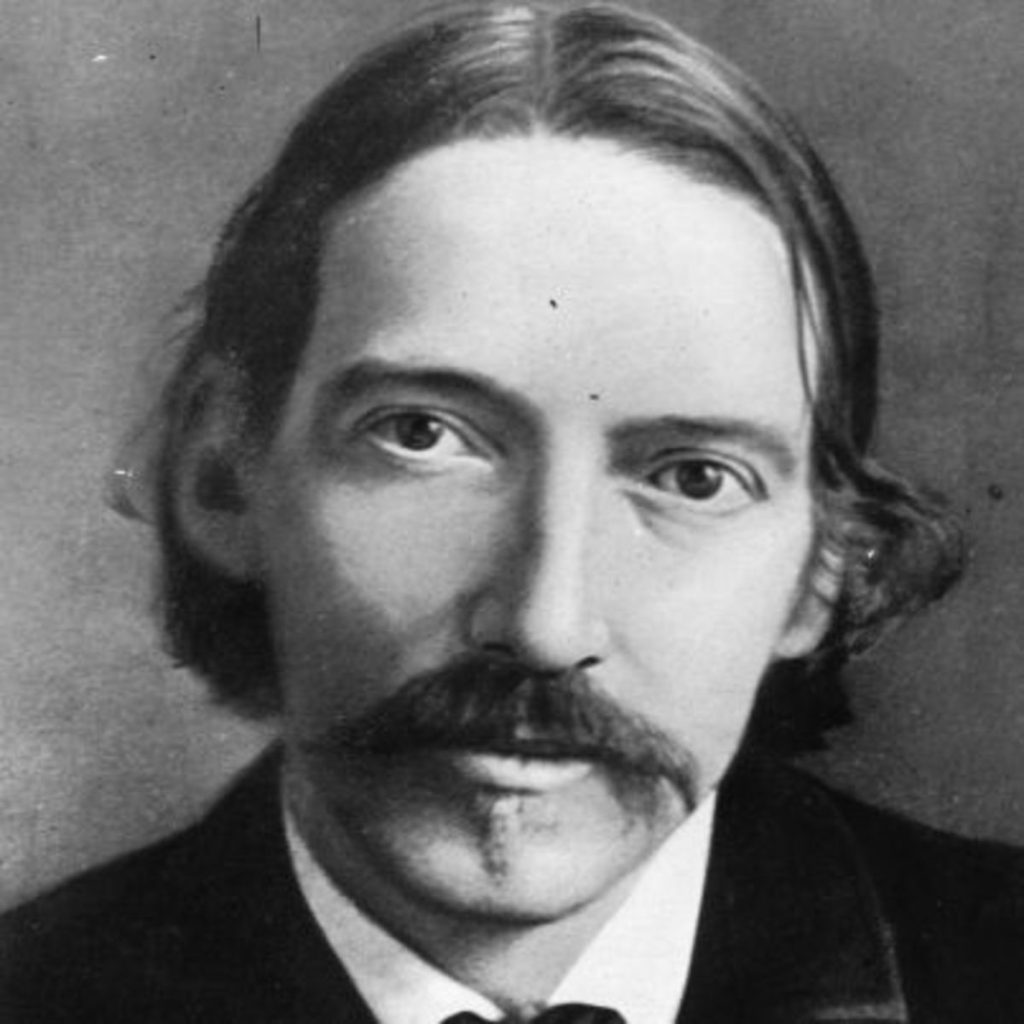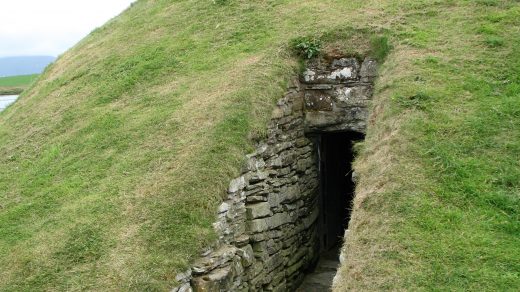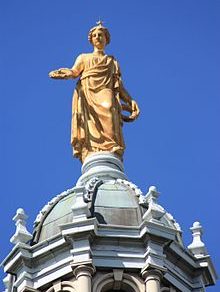Robert Louis Stevenson (13 November 1850 – 3 December 1894) was a Scottish novelist and travel writer, most noted for Treasure Island, Kidnapped, Strange Case of Dr Jekyll and Mr Hyde, and A Child’s Garden of Verses.
Born and educated in Edinburgh, Stevenson suffered from serious bronchial trouble for much of his life, but continued to write prolifically and travel widely in defiance of his poor health. As a young man, he mixed in London literary circles, receiving encouragement from Andrew Lang, Edmund Gosse, Leslie Stephen and W. E. Henley, the last of whom may have provided the model for Long John Silver in Treasure Island. In 1890, he settled in Samoa, where he died in 1894.

A celebrity in his lifetime, Stevenson’s critical reputation has fluctuated since his death, though today his works are held in general acclaim. He is currently ranked as the 26th most translated author in the world.
Childhood and youth
Stevenson was born at 8 Howard Place, Edinburgh, Scotland on 13 November 1850 to Thomas Stevenson (1818–1887), a leading lighthouse engineer, and his wife Margaret Isabella (born Balfour, 1829–1897). He was christened Robert Lewis Balfour Stevenson.At about age 18, he changed the spelling of “Lewis” to “Louis”, and he dropped “Balfour” in 1873. Lighthouse design was the family’s profession; Thomas’s father (Robert’s grandfather) was civil engineer Robert Stevenson, and Thomas’s brothers (Robert’s uncles) Alan and David were in the same field. Thomas’s maternal grandfather Thomas Smith had been in the same profession. However, Robert’s mother’s family were gentry, tracing their lineage back to Alexander Balfour who had held the lands of Inchyra in Fife in the fifteenth century. His mother’s father Lewis Balfour (1777–1860) was a minister of the Church of Scotland at nearby Colinton, and her siblings included physician George William Balfour and marine engineer James Balfour. Stevenson spent the greater part of his boyhood holidays in his maternal grandfather’s house. “Now I often wonder what I inherited from this old minister,” Stevenson wrote. “I must suppose, indeed, that he was fond of preaching sermons, and so am I, though I never heard it maintained that either of us loved to hear them.”
Lewis Balfour and his daughter both had weak chests, so they often needed to stay in warmer climates for their health. Stevenson inherited a tendency to coughs and fevers, exacerbated when the family moved to a damp, chilly house at 1 Inverleith Terrace in 1851. The family moved again to the sunnier 17 Heriot Row when Stevenson was six years old, but the tendency to extreme sickness in winter remained with him until he was 11. Illness was a recurrent feature of his adult life and left him extraordinarily thin. Contemporaneous views were that he had tuberculosis, but more recent views are that it was bronchiectasis or even sarcoidosis.
Stevenson’s parents were both devout Presbyterians, but the household was not strict in its adherence to Calvinist principles. His nurse Alison Cunningham (known as Cummy) was more fervently religious. Her mix of Calvinism and folk beliefs were an early source of nightmares for the child, and he showed a precocious concern for religion. But she also cared for him tenderly in illness, reading to him from John Bunyan and the Bible as he lay sick in bed and telling tales of the Covenanters. Stevenson recalled this time of sickness in “The Land of Counterpane” in A Child’s Garden of Verses (1885), dedicating the book to his nurse.
Stevenson was an only child, both strange-looking and eccentric, and he found it hard to fit in when he was sent to a nearby school at age 6, a problem repeated at age 11 when he went on to the Edinburgh Academy; but he mixed well in lively games with his cousins in summer holidays at Colinton. His frequent illnesses often kept him away from his first school, so he was taught for long stretches by private tutors. He was a late reader, learning at age 7 or 8, but even before this he dictated stories to his mother and nurse, and he compulsively wrote stories throughout his childhood. His father was proud of this interest; he had also written stories in his spare time until his own father found them and told him to “give up such nonsense and mind your business.” He paid for the printing of Robert’s first publication at 16, entitled The Pentland Rising: A Page of History, 1666. It was an account of the Covenanters’ rebellion which was published in 1866, the 200th anniversary of the event.
Education
In September 1857, Stevenson went to Mr Henderson’s School in India Street, Edinburgh, but because of poor health stayed only a few weeks and did not return until October 1859. During his many absences, he was taught by private tutors. In October 1861, he went to Edinburgh Academy, an independent school for boys, and stayed there sporadically for about fifteen months. In the autumn of 1863, he spent one term at an English boarding school at Spring Grove in Isleworth in Middlesex (now an urban area of West London). In October 1864, following an improvement to his health, he was sent to Robert Thomson’s private school in Frederick Street, Edinburgh, where he remained until he went to university. In November 1867, Stevenson entered the University of Edinburgh to study engineering. He showed from the start no enthusiasm for his studies and devoted much energy to avoiding lectures. This time was more important for the friendships he made with other students in the Speculative Society (an exclusive debating club), particularly with Charles Baxter, who would become Stevenson’s financial agent, and with a professor, Fleeming Jenkin, whose house staged amateur drama in which Stevenson took part, and whose biography he would later write. Perhaps most important at this point in his life was a cousin, Robert Alan Mowbray Stevenson (known as “Bob”), a lively and light-hearted young man who, instead of the family profession, had chosen to study art. Each year during vacations, Stevenson travelled to inspect the family’s engineering works—to Anstruther and Wick in 1868, with his father on his official tour of Orkney and Shetland islands lighthouses in 1869, and for three weeks to the island of Erraid in 1870. He enjoyed the travels more for the material they gave for his writing than for any engineering interest. The voyage with his father pleased him because a similar journey of Walter Scott with Robert Stevenson had provided the inspiration for Scott’s 1822 novel The Pirate. In April 1871, Stevenson notified his father of his decision to pursue a life of letters. Though the elder Stevenson was naturally disappointed, the surprise cannot have been great, and Stevenson’s mother reported that he was “wonderfully resigned” to his son’s choice. To provide some security, it was agreed that Stevenson should read Law (again at Edinburgh University) and be called to the Scottish bar. In his 1887 poetry collection Underwoods, Stevenson muses on his having turned from the family profession:
Say not of me that weakly I declined
The labours of my sires, and fled the sea,
The towers we founded and the lamps we lit,
To play at home with paper like a child.
But rather say: In the afternoon of time
A strenuous family dusted from its hands
The sand of granite, and beholding far
Along the sounding coast its pyramids
And tall memorials catch the dying sun,
Smiled well content, and to this childish task
Around the fire addressed its evening hours.
In other respects too, Stevenson was moving away from his upbringing. His dress became more Bohemian; he already wore his hair long, but he now took to wearing a velveteen jacket and rarely attended parties in conventional evening dress. Within the limits of a strict allowance, he visited cheap pubs and brothels. More importantly, he had come to reject Christianity and declared himself an atheist. In January 1873, his father came across the constitution of the LJR (Liberty, Justice, Reverence) Club, of which Stevenson and his cousin Bob were members, which began: “Disregard everything our parents have taught us”. Questioning his son about his beliefs, he discovered the truth, leading to a long period of dissension with both parents:
What a damned curse I am to my parents! As my father said, “You have rendered my whole life a failure”. As my mother said, “This is the heaviest affliction that has ever befallen me”. O Lord, what a pleasant thing it is to have damned the happiness of (probably) the only two people who care a damn about you in the world.
Early writing and travels
Stevenson, c. 1877
Stevenson was visiting a cousin in England in late 1873 when he met two people who became very important to him: Sidney Colvin and Fanny (Frances Jane) Sitwell. Sitwell was a 34-year-old woman with a son, who was separated from her husband. She attracted the devotion of many who met her, including Colvin, who married her in 1901. Stevenson was also drawn to her, and they kept up a warm correspondence over several years in which he wavered between the role of a suitor and a son (he addressed her as “Madonna”). Colvin became Stevenson’s literary adviser and was the first editor of his letters after his death. He placed Stevenson’s first paid contribution in The Portfolio, an essay entitled “Roads”.
Stevenson was soon active in London literary life, becoming acquainted with many of the writers of the time, including Andrew Lang, Edmund Gosse, and Leslie Stephen, the editor of the Cornhill Magazine who took an interest in Stevenson’s work. Stephen took Stevenson to visit a patient at the Edinburgh Infirmary named William Ernest Henley, an energetic and talkative man with a wooden leg. Henley became a close friend and occasional literary collaborator, until a quarrel broke up the friendship in 1888, and he is often considered to be the model for Long John Silver in Treasure Island.

Stevenson was sent to Menton on the French Riviera in November 1873 to recuperate after his health failed. He returned in better health in April 1874 and settled down to his studies, but he returned to France several times after that. He made long and frequent trips to the neighborhood of the Forest of Fontainebleau, staying at Barbizon, Grez-sur-Loing, and Nemours and becoming a member of the artists’ colonies there. He also traveled to Paris to visit galleries and the theatres. He qualified for the Scottish bar in July 1875, and his father added a brass plate to the Heriot Row house reading “R.L. Stevenson, Advocate”. His law studies did influence his books, but he never practised law; all his energies were spent in travel and writing. One of his journeys was a canoe voyage in Belgium and France with Sir Walter Simpson, a friend from the Speculative Society, a frequent travel companion, and the author of The Art of Golf (1887). This trip was the basis of his first travel book An Inland Voyage (1878).
Marriage
Fanny Van de Grift Osbourne, c. 1876
The canoe voyage with Simpson brought Stevenson to Grez in September 1876 where he met Fanny Van de Grift Osbourne (1840–1914), born in Indianapolis. She had married at age 17 and moved to Nevada to rejoin husband Samuel after his participation in the American Civil War. Their children were Isobel (or “Belle”), Lloyd, and Hervey (who died in 1875). But anger over her husband’s infidelities led to a number of separations. In 1875, she had taken her children to France where she and Isobel studied art.
Stevenson returned to Britain shortly after this first meeting, but Fanny apparently remained in his thoughts, and he wrote the essay “On falling in love” for the Cornhill Magazine. They met again early in 1877 and became lovers. Stevenson spent much of the following year with her and her children in France. In August 1878, she returned to San Francisco and Stevenson remained in Europe, making the walking trip that formed the basis for Travels with a Donkey in the Cévennes (1879). But he set off to join her in August 1879, against the advice of his friends and without notifying his parents. He took second-class passage on the steamship Devonia, in part to save money but also to learn how others travelled and to increase the adventure of the journey. He then traveled overland by train from New York City to California. He later wrote about the experience in The Amateur Emigrant. It was good experience for his writing, but it broke his health.
French Hotel (now “Stevenson House”), Monterey, California where he stayed in 1879
He was near death when he arrived in Monterey, California, where some local ranchers nursed him back to health. He stayed for a time at the French Hotel located at 530 Houston Street, now a museum dedicated to his memory called the “Stevenson House”. While there, he often dined “on the cuff,” as he said, at a nearby restaurant run by Frenchman Jules Simoneau, which stood at what is now Simoneau Plaza; several years later, he sent Simoneau an inscribed copy of his novel Strange Case of Dr Jekyll and Mr Hyde (1886), writing that it would be a stranger case still if Robert Louis Stevenson ever forgot Jules Simoneau. While in Monterey, he wrote an evocative article about “the Old Pacific Capital” of Monterey.
By December 1879, Stevenson had recovered his health enough to continue to San Francisco where he struggled “all alone on forty-five cents a day, and sometimes less, with quantities of hard work and many heavy thoughts,” in an effort to support himself through his writing. But by the end of the winter, his health was broken again and he found himself at death’s door. Fanny was now divorced and recovered from her own illness, and she came to his bedside and nursed him to recovery. “After a while,” he wrote, “my spirit got up again in a divine frenzy, and has since kicked and spurred my vile body forward with great emphasis and success.” When his father heard of his condition, he cabled him money to help him through this period.
Fanny and Robert were married in May 1880, although he said that he was “a mere complication of cough and bones, much fitter for an emblem of mortality than a bridegroom.”He travelled with his new wife and her son Lloyd north of San Francisco to Napa Valley and spent a summer honeymoon at an abandoned mining camp on Mount Saint Helena (today designated Robert Louis Stevenson State Park). He wrote about this experience in The Silverado Squatters. He met Charles Warren Stoddard, co-editor of the Overland Monthly and author of South Sea Idylls, who urged Stevenson to travel to the South Pacific, an idea which returned to him many years later. In August 1880, he sailed with Fanny and Lloyd from New York to Britain and found his parents and his friend Sidney Colvin on the wharf at Liverpool, happy to see him return home. Gradually, his wife was able to patch up differences between father and son and make herself a part of the family through her charm and wit.
Attempted settlement in Europe and the US
Stevenson’s “Cure Cottage” in Saranac Lake, New York
Stevenson searched in vain between 1880 and 1887 for a residence suitable to his health. He spent his summers at various places in Scotland and England, including Westbourne, Dorset, a residential area in Bournemouth. It was during his time in Bournemouth that he wrote the story Strange Case of Dr Jekyll and Mr Hyde, naming the character Mr. Poole after the town of Poole which is situated next to Bournemouth. In Westbourne, he named his house Skerryvore after the tallest lighthouse in Scotland, which his uncle Alan had built (1838–44). In the wintertime, Stevenson travelled to France and lived at Davos Platz and the Chalet de Solitude at Hyères, where he was very happy for a time. “I have so many things to make life sweet for me,” he wrote, “it seems a pity I cannot have that other one thing—health. But though you will be angry to hear it, I believe, for myself at least, what is is best.” In spite of his ill health, he produced the bulk of his best-known work during these years. Treasure Island was published under the pseudonym “Captain George North” and became his first widely popular book; he wrote it during this time, along with Kidnapped, Strange Case of Dr Jekyll and Mr Hyde (which established his wider reputation), The Black Arrow: A Tale of the Two Roses, A Child’s Garden of Verses, and Underwoods. He gave a copy of Kidnapped to his friend and frequent Skerryvore visitor Henry James.
His father died in 1887 and Stevenson felt free to follow the advice of his physician to try a complete change of climate, so he headed for Colorado with his mother and family. But after landing in New York, they decided to spend the winter in the Adirondacks at a cure cottage now known as Stevenson Cottage at Saranac Lake, New York. During the intensely cold winter, Stevenson wrote some of his best essays, including Pulvis et Umbra. He also began The Master of Ballantrae and lightheartedly planned a cruise to the southern Pacific Ocean for the following summer.
Politics
Stevenson believed in Conservatism for most of his life. His cousin and biographer Sir Graham Balfour said that “he probably throughout life would, if compelled to vote, have always supported the Conservative candidate.” In 1866, Stevenson voted for Benjamin Disraeli, future Conservative Prime Minister of the United Kingdom, over Thomas Carlyle for the Lord Rectorship of the University of Edinburgh. During his college years, he briefly identified himself as a “red-hot socialist”. He wrote at age 26: “I look back to the time when I was a Socialist with something like regret…. Now I know that in thus turning Conservative with years, I am going through the normal cycle of change and travelling in the common orbit of men’s opinions.”
Journey to the Pacific
In June 1888, Stevenson chartered the yacht Casco and set sail with his family from San Francisco. The vessel “plowed her path of snow across the empty deep, far from all track of commerce, far from any hand of help.” The sea air and thrill of adventure for a time restored his health, and for nearly three years he wandered the eastern and central Pacific, stopping for extended stays at the Hawaiian Islands, where he became a good friend of King Kalākaua. He befriended the king’s niece Princess Victoria Kaiulani, who also had Scottish heritage. He spent time at the Gilbert Islands, Tahiti, New Zealand, and the Samoan Islands. During this period, he completed The Master of Ballantrae, composed two ballads based on the legends of the islanders, and wrote The Bottle Imp. He preserved the experience of these years in his various letters and in his In the South Seas (which was published posthumously). He made a voyage in 1889 with Lloyd on the trading schooner Equator, visiting Butaritari, Mariki, Apaiang, and Abemama in the Gilbert Islands. They spent several months on Abemama with tyrant-chief Tem Binoka, whom Stevenson described in In the South Seas.
Stevenson left Sydney, Australia, on the Janet Nicoll in April 1890 for his third and final voyage among the South Seas islands. He intended to produce another book of travel writing to follow his earlier book In the South Seas, but it was his wife who eventually published her journal of their third voyage. (Fanny misnames the ship in her account The Cruise of the Janet Nichol.) A fellow passenger was Jack Buckland, whose stories of life as an island trader became the inspiration for the character of Tommy Hadden in The Wrecker (1892), which Stevenson and Lloyd Osbourne wrote together. Buckland visited the Stevensons at Vailima in 1894.
Last years
In 1890, Stevenson purchased a tract of about 400 acres (1.6 km²) in Upolu, an island in Samoa where he established himself on his estate in the village of Vailima after two aborted attempts to visit Scotland. He took the native name Tusitala (Samoan for “Teller of Tales”). His influence spread among the Samoans, who consulted him for advice, and he soon became involved in local politics. He was convinced that the European officials who had been appointed to rule the Samoans were incompetent, and he published A Footnote to History after many futile attempts to resolve the matter. This was such a stinging protest against existing conditions that it resulted in the recall of two officials, and Stevenson feared for a time that it would result in his own deportation. He wrote to Colvin, “I used to think meanly of the plumber; but how he shines beside the politician!”
He also found time to work at his writing, although he felt that “there was never any man had so many irons in the fire”. He wrote The Beach of Falesa, Catriona (titled David Balfour in the US), The Ebb-Tide, and the Vailima Letters during this period.
Stevenson grew depressed and wondered if he had exhausted his creative vein, as he had been “overworked bitterly” and that the best he could write was “ditch-water”. He even feared that he might again become a helpless invalid. He rebelled against this idea: “I wish to die in my boots; no more Land of Counterpane for me. To be drowned, to be shot, to be thrown from a horse — ay, to be hanged, rather than pass again through that slow dissolution.” He then suddenly had a return of energy and he began work on Weir of Hermiston. “It’s so good that it frightens me,” he is reported to have exclaimed. He felt that this was the best work he had done.
On 3 December 1894, Stevenson was talking to his wife and straining to open a bottle of wine when he suddenly exclaimed, “What’s that?”, asked his wife “does my face look strange?”, and collapsed. He died within a few hours, probably of a cerebral haemorrhage. He was 44 years old. The Samoans insisted on surrounding his body with a watch-guard during the night and on bearing him on their shoulders to nearby Mount Vaea, where they buried him on a spot overlooking the sea on land donated by British Acting Vice Consul Thomas Trood. Stevenson had always wanted his Requiem inscribed on his tomb:
Under the wide and starry sky, Dig the grave and let me lie. Glad did I live and gladly die, And I laid me down with a will. This be the verse you grave for me: Here he lies where he longed to be; Home is the sailor, home from sea, And the hunter home from the hill.
Stevenson was loved by the Samoans, and his tombstone epigraph was translated to a Samoan song of grief.




Fascinating to be sure. Imagine what he could have written had he been in good health.
Thanks for sharing. Allan
One of my fav authors for sure Thank you Allan, be safe mate.
The Johann Miesner Family in Scheeßel Church Records
thank you friend.
I didn’t realize Stevenson was a Scotsman. Interesting post, as usual.
yes he was friend, and wrote my all time fav, treasure island. THANK YOU.